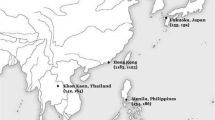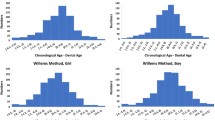Abstract
Reference data for dental age estimate is sparse in New Zealand (NZ), with only two contemporary studies. Te Moananui et al. (J For Sci. 53(2), 2008) presented modified Demirjian percentile curves to estimate dental age of Pasifika, Māori, and European males and females (n = 1383), while Timmins et al. (Forensic Sci Med Pathol. 8:101–8, 2012) found the Demirjian method (1973) was valid for a smaller sample (n = 200) of unknown ancestry. The study presented here sought to validate the Demirjian and the Te Moananui methods for a sample of the NZ population of unknown ancestry and a subgroup of known ancestry i.e., Pasifika, Māori and European, for males and females. The Demirjian method (1976) was applied to the current study's sample consisting of 3523 individuals aged 4 to < 20 years. The seven left mandibular teeth (third molar excluded) and tooth scores were summed for each individual, with the Te Moananui methods applied to this subgroup. The results revealed these methods to be less than ideal for estimating dental age of the NZ sample, for both males and females. The probit regression form of Transition Analysis (TA) was employed to calculate the mean age entering each tooth stage, for the seven teeth, to reduce age mimicry that is commonly associated with traditional regression analysis. TA results revealed Pasifika and Māori individuals to be more advanced than Caucasian individuals. The sex groups were also compared to the mean ages presented by Demirjian and Levesque with mixed results (J Dent Res. 59(7):1110–22, 1980), highlighting the need for more research in this area.



Similar content being viewed by others
Data availability
N/A.
Notes
Te Moananui use the term European in their study and is used here for consistency, whereas elsewhere in this paper the term Caucasian is used instead.
FDI notation of teeth.
31 = I1, 32 = I2, 33 = C, 34 = PM1, 35 = PM2, 36 = M1, 37 = M2.
References
Demirjian A, Goldstein TJ. A new system of dental age assessment. Hum Biol. 1973;45:211–27.
Demirjian A, Goldstein H. New systems for dental maturity based on seven and four teeth. Hum Biol. 1976;3(5):411–21. https://doi.org/10.1080/03014467600001671.
Jayaraman J, et al. Development of a reference data set (RDS) for dental age estimation (DAE) and testing of this with a separate validation set (VS) in a southern Chinese population. J Forensic Leg Med. 2016;43:26–33. https://doi.org/10.1016/j.jflm.2016.07.007.
Roberts G, Lucas V, McDonald F. Age estimation in the living: Dental age estimation – theory and practice. Encycl Forensic Leg Med. 2016. https://doi.org/10.1016/B978-0-12-800034-2.00007-0.
Te Moananui R, et al. Estimating age in Maori, Pacific Island, and European children from New Zealand. J For Sci. 2008;53(2).
Blenkin M. Forensic dentistry and its application in age estimation from the teeth using a modified Demirjian system. Thesis doctoral 2006. University of Sydney, NSW, Australia. Available at: https://ses.library.usyd.edu.au/handle/2123/5036.
Blenkin M, Evans W. Age estimation from the teeth using a modified Demirjian system. J For Sci. 2010;55(6):1504–8.
Mincer H, Harris E, Berryman H. The A.B.F.O. study of third molar development and its use as an estimator of chronological age. J For Sci. 1993;38(2):379–90.
Bassed R, Briggs C, Drummer O. Age estimation using CT imaging of the third molar tooth, the medial clavicular epiphysis, and the spheno-occipital synchondrosis: a multifactorial approach. For Sci Int. 2011;212(1):273.e1-273e5.
Olze A, et al. Validation of common classification systems for assessing the mineralization of third molars. Int J Legal Med. 2005;119(1):22–6. https://doi.org/10.1007/s00414-004-0489-5.
Kanagaratnam S, Schluter P. The age of permanent tooth emergence in children of different ethnic origin in the Auckland region: a cross-sectional study. N Z Dent J. 2012;108(No. 2 June):55–61.
Timmins K, et al. The usefulness of dental and cervical maturation stages in New Zealand children for Disaster Victim Identification. Forensic Sci Med Pathol. 2012;8:101–8.
Te Moananui R. Dental Age of New Zealand Adolescents [Unpublished master's thesis]. University of Otago. 2006.
Demirjian A. Dental development. CD-ROM. 1993. Montreal: Silver Platter Education.
Landis JR, Koch GG. The measurement of observer agreement for categorical data. Biometrics. 1977;33(1):159. https://doi.org/10.2307/2529310.
Liversidge H. Interpreting group differences using demirjian’s dental maturity method. For Sci Int. 2010;201(1):95–101.
Tangmose S, et al. Age estimation in the living: Transition analysis on developing third molars. For Sci Int. 2015;257:512.e1–512.e7. https://doi.org/10.1016/j.forsciint.2015.07.049.
Acharya AB. Accuracy of predicting 18 years of age from mandibular third molar development in an Indian sample using Demirjian’s ten-stage criteria. Int J Legal Med. 2011;125(2):227–33. https://doi.org/10.1007/s00414-010-0522-9.
Prince DA, Konigsberg LW. New formulae for estimating age-at-death in the Balkans utilizing Lamendin’s dental technique and Bayesian analysis. J For Sci. 2008;53(3):578–87. https://doi.org/10.1111/j.1556-4029.2008.00713.x.
Konigsberg LW. Multivariate cumulative probit for age estimation using ordinal categorical data’. Hum Biol. 2015;42(4):368–78. https://doi.org/10.3109/03014460.2015.1045430.
Boldsen J, et al. Transition Analysis: A new method for estimating age from skeletons.In: Hoppa RD, Vaupel JW, editors. Paleodemography. Age distributions from skeletal samples. Cambridge. 2002:73–106. https://doi.org/10.1017/CBO9780511542428.005.
Demirjian A, Levesque G. Sexual differences in dental development and prediction of emergence. J Dent Res. 1980;59(7):1110–22.
Elamin F, Hector MP, Liversidge HM. The timing of mandibular tooth formation in two African groups’. Hum Biol. 2017;44(3):261–72. https://doi.org/10.1080/03014460.2016.1213313.
Liversidge HM, Smith BH, Maber M. Bias and accuracy of age estimation using developing teeth in 946 children. Am J Phys Anthropol. 2010;43(4):545–54. https://doi.org/10.1002/ajpa.21349.
Fanning EA. A longitudinal study of tooth formation and root resorption. NZ Dental Journal. 1961;57:202–17.
Konigsberg LW, et al. Estimation and evidence in forensic anthropology: Age-at-death. J For Sci. 2008;53(3):541–57. https://doi.org/10.1111/j.1556-4029.2008.00710.x.
Moorrees CFA, Fanning EA, Hunt HE. Age variation of formation stages for ten permanent teeth. J Dent Res. 1963;42:1490–502.
Konigsberg LW, Frankenberg SR, Liversidge HM. Status of mandibular third molar development as evidence in legal age threshold cases. J For Sci. 2019;64(3):680–97. https://doi.org/10.1111/1556-4029.13926.
Home Office United Kingdom. Biological evaluation methods to assist in assessing the age of unaccompanied asylum-seeking children. 2022. https://www.gov.uk/government/publications/methods-to-assess-the-age-of-unaccompanied-asylum-seeking-children/biological-evaluation-methods-to-assist-in-assessing-the-age-of-unaccompanied-asylum-seeking-children-accessible. Accessed 12 June 2023
Schmeling A, et al. Forensische altersdiagnostik : Methoden, aussagesicherheit, rechtsfragen. Dtsch Arztebl Int. 2016;113(4):44–50. https://doi.org/10.3238/arztebl.2016.0044.
Acknowledgements
Many thanks to Professor Helen Liversidge and Professor Lyle Konigsberg for their advice on statistical questions, and to Dr. Hugh Trengrove for his clinical assistance.
Funding
No funds, grants, or other support was received.
Author information
Authors and Affiliations
Contributions
N/A.
Corresponding author
Ethics declarations
Ethics approval
This research study was conducted retrospectively from data obtained for clinical purposes and considered low risk. Ethics approval was sought from and approved by Auckland Health Research Ethics Committee (NZ). Reference number: 000110.
Consent
N/A.
Conflict of interests
The authors have no financial or proprietary interests in any material discussed in this article.
Additional information
Publisher's Note
Springer Nature remains neutral with regard to jurisdictional claims in published maps and institutional affiliations.
Classifications
10: Forensics/ 10.010:Pathology 10.030:Science 10.070:Identification 10.090:Anthropology 10.200Mass Fatalities 10.210:Odontology.
Appended Tables
Appended Tables
Rights and permissions
Springer Nature or its licensor (e.g. a society or other partner) holds exclusive rights to this article under a publishing agreement with the author(s) or other rightsholder(s); author self-archiving of the accepted manuscript version of this article is solely governed by the terms of such publishing agreement and applicable law.
About this article
Cite this article
Baylis, S., Dipnall, J.F. & Bassed, R. Estimating dental age of New Zealand juveniles and subadults using Demirjian's method. Forensic Sci Med Pathol (2024). https://doi.org/10.1007/s12024-024-00803-w
Accepted:
Published:
DOI: https://doi.org/10.1007/s12024-024-00803-w




